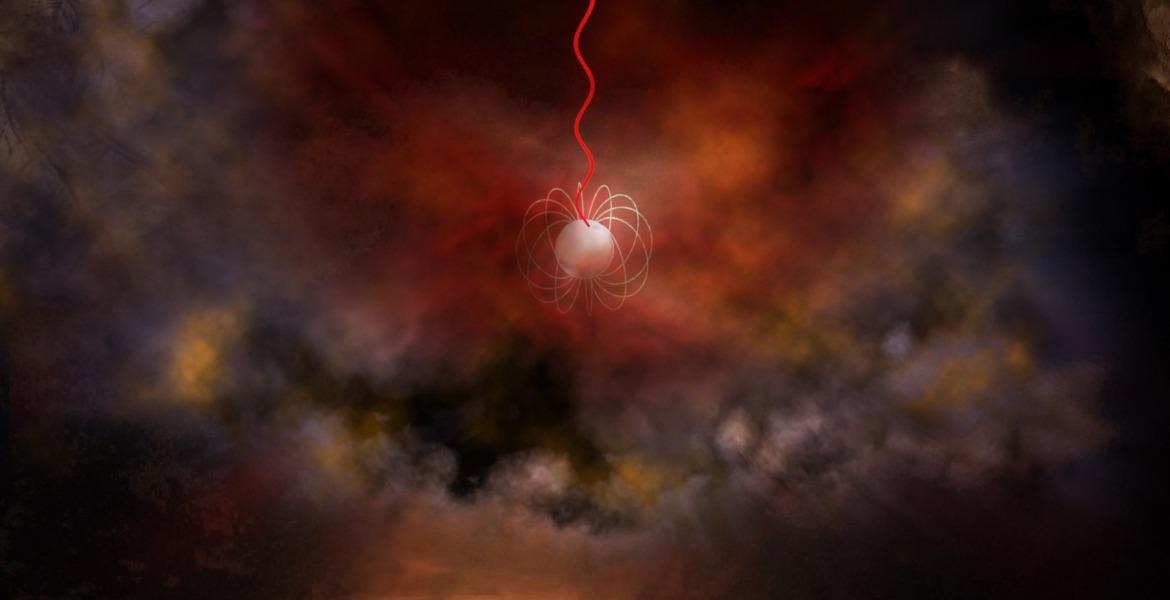Reviewed by Alex SmithJun 9 2022
Astronomers have discovered just the second example of a very active, repeated Fast Radio Burst (FRB) with a limited source of weaker but sustained radio emission between bursts.
 Artist's conception of a neutron star with an ultra-strong magnetic field, called a magnetar, emitting radio waves (red). Magnetars are a leading candidate for what generates Fast Radio Bursts. Image Credit: Bill Saxton, NRAO/AUI/NSF.
Artist's conception of a neutron star with an ultra-strong magnetic field, called a magnetar, emitting radio waves (red). Magnetars are a leading candidate for what generates Fast Radio Bursts. Image Credit: Bill Saxton, NRAO/AUI/NSF.
The revelation poses questions regarding the nature of these enigmatic objects, as well as their utility as research tools into the nature of intergalactic space. The object, initially spotted in 2019, was studied using the National Science Foundation’s Karl G. Jansky Very Large Array (VLA) and other telescopes.
The object, known as FRB 190520, was discovered by China’s FAST (Five-hundred-meter Aperture Spherical radio Telescope). On May 20th, 2019, the object burst, and information from that telescope was found in November of the same year. FAST, unlike many other FRBs, releases frequent, repetitive bursts of radio waves, according to follow-up observations.
The object’s location was established by measurements with the VLA in 2020, which allowed visible-light studies with the Subaru telescope in Hawaii to demonstrate that it is on the borders of a dwarf galaxy roughly three billion light-years from Earth. Among bursts, the object produces weaker radio waves, according to the VLA data.
These characteristics make this one look a lot like the very first FRB whose position was determined—also by the VLA—back in 2016.
Casey Law, California Institute of Technology
That achievement was significant since it provided the first data on an FRB’s environment and distance. However, the 2016 object, known as FRB 121102, was distinguished from all other reported FRBs by its combination of repetitive bursts and continuous radio emission among bursts, which came from a compact location.
Now we have two like this, and that brings up some important questions.
Casey Law, California Institute of Technology
Law is one of a group of astronomers from around the world who published their study in the journal Nature.
The distinctions between FRB 190520 and FRB 121102, as well as all the others, support the hypothesis that there are two types of FRBs.
Are those that repeat different from those that don’t? What about the persistent radio emission—is that common?
Kshitij Aggarwal, Graduate Student, West Virginia University
The astronomers speculate that FRBs could be produced by two separate processes or by objects that function differently at various stages of their existence. The superdense neutron stars left over after a big star explodes as a supernova, or neutron stars with ultra-strong magnetic fields, known as magnetars, are the most likely producers of FRBs.
The efficacy of FRBs as tools for examining the material between them and Earth is called into doubt by one feature of FRB 190520.
Astronomers frequently study the effects of intervening material on radio waves radiated by faraway objects to understand more about that flimsy material.
When radio waves flow across space containing free electrons, one such effect happens. In that situation, higher-frequency waves travel more swiftly than lower-frequency waves.
This effect, termed dispersion, can be investigated to evaluate the density of electrons in the space between the object and Earth or to offer a rough approximation of the distance to the object if the electron density is understood or assumed. The effect is frequently used to calculate pulsar distances.
For FRB 190520, that did not work. The galaxy is roughly three billion light-years away from Earth, according to an independent assessment based on the Doppler shift of the galaxy’s light induced by the expansion of the Universe. The burst’s signal, on the other hand, has a level of dispersion that would normally indicate a distance of 8 to 9.5 billion light-years.
“This means that there is a lot of material near the FRB that would confuse any attempt to use it to measure the gas between galaxies,” Aggarwal said. “If that’s the case with others, then we can’t count on using FRBs as cosmic yardsticks,” he added.
FRB 190520 may be a “newborn,” still encircled by dense material blasted by the supernova explosion that left behind the neutron star, according to the astronomers. The spread of the burst signals would similarly decrease as that substance degrades. According to them, the recurring bursts may be a feature of younger FRBs and fade with age in the “newborn” case.
“The FRB field is moving very fast right now and discoveries are coming out monthly. However, big questions remain, and this object is giving us challenging clues about those questions,” said Sarah Burke-Spolaor, of WVU.
The National Radio Astronomy Observatory is a National Science Foundation facility that is run by Associated Universities, Inc. under a cooperative agreement.
Repeating Fast Radio Burst
Animation of the sequence of events producing the fast radio burst. Video Credit: Bill Saxton, NRAO/AUI/NSF.
Journal Reference:
Niu, C.-H., et al. (2022) A repeating fast radio burst associated with a persistent radio source. Nature. doi.org/10.1038/s41586-022-04755-5.